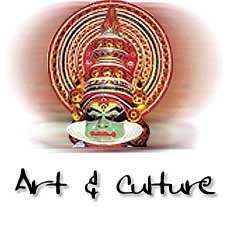CLASSICAL
ARTS OF KERALA
KATHAKALI
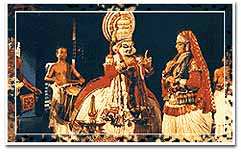 Kathakali is one of the ancient, traditional art form of kerala. Kathakali is an art form unique to kerala. The origin of this great art form can be traced back to centuries. Kathakali has recieved immense appreciation among the art lovers , world over. The "Mudras" and costumes of kathakali are truely unique in itself. Kathakali expresses itself through facial expressions and hand gestures(mudras). Stories from great epics like ramayana and mahabharatha forms the main subject for this art form. Let's all be proud to present this magnificient art to the world !!.
Kathakali is one of the ancient, traditional art form of kerala. Kathakali is an art form unique to kerala. The origin of this great art form can be traced back to centuries. Kathakali has recieved immense appreciation among the art lovers , world over. The "Mudras" and costumes of kathakali are truely unique in itself. Kathakali expresses itself through facial expressions and hand gestures(mudras). Stories from great epics like ramayana and mahabharatha forms the main subject for this art form. Let's all be proud to present this magnificient art to the world !!.
This spectacular classical dance drama of kerala based on the guidelines
laid by sage bharatha's natya sastra, the ancient treatise on dance and
drama, is over 500 years old. This elaborate art form is usually performed
in the evenings and continues up to dawn, and is an integral part of all
temple and cultural festivals in kerala. The costumes and makeup are
ornamental, elaborate and designed to give a superhuman effect. The actors
do not speak or sing but enact the story through mudras (hand gestures),
graceful movements and facial expressions. The themes of this awe
inspiring art are taken from india's rich and colourful mythology. Music
is an essential feature of kathakali, with two vocalists who sing to the
accompaniment of a chengila (gong), elathalam (small cymbals), chenda and
maddalam.
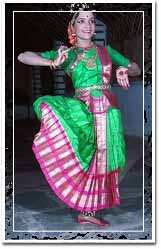 BHARATA
NATYAM BHARATA
NATYAM
It is believed to be india's oldest form of classical dance. This dance
form which is called poetry in motion, has its hoary origins in the natya
sastra written about 4000 b.c. by sage bharatha. This art form grossly
disallows new fangled innovations or gimmicks except in repertoire and
forms of presentation. It was originally known as 'dasi attam,' a temple
art performed by young women called 'devadasis.'
Bharatha natyam is commonly performed by women, but sometimes by men
also. There are strict guidelines laid down regarding every single aspect
of the art including the attributes required in order to be an
accomplished dancer.
CHAKYARKOOTHU
Also called koothu, is one of the oldest classical theatre arts of kerala.
The solo dance is usually presented in the koothambalam of temples to the
accompaniment of the mizhavu and elathalam. The performance begains with
an invocation to the presiding deity of the temple. The narration is
enlivened with the thandava dance movements, gestures and facial
expression according to the guidelines in natya sastra. Koothu is distinct
for its comic element which adds to its dramatic character. Themes are
usually from the epics. The costume is colourful and bizarre with a
strange headgear
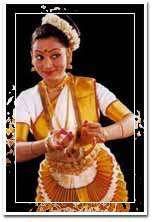 MOHINIYATTAM MOHINIYATTAM
This
classical solo dance form combines the graceful elegance of bharatanatyam
with the vigour and dynamism of kathakali, to create a mood that is
predominantly sringara (erotic). The dance is usually performed on
specially put up stages in connection with temple festivals. The costume
is the traditional white mundu and melmundu of kerala. The hair is
gathered and put up at the side of the head and adorned with jasmine, int
the traditional style.
FOLK ARTS OF KERALA
KALARIPAYATTU
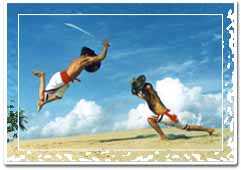
Kalaripayattu is the comprehensive system of martial arts of kerala,
regarded as one of the oldest and most scientific in the world.
Kalaripayattu training aims at the ultimate co-ordination of mind and
body. The traditional training in a kalari includes specialisation in
indigenous medical practices too. Kalaris are also centres of religious
worship.
THIRUVATHIRAKALI
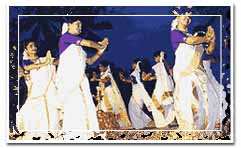
Thiruvathirakali is a classical dance form, which is a pointer to the old
customs followed in the nair tharawads (joint families). In this dance
form, the women of the house dance elegantly around the ceremonial lamp or
floral decoration on festive occasions to the accompaniment of the
thiruvathira pattu (song).
KALIYOOTTU
Kaliyoottu is an eight day long colourful folk ritual which been acts the
combat between goddess durga and the demon darika. The ritual is performed
in different stages. The climax of the play - the ritual called paranettu
- is performed on a specially constructed 100 feet high stage on the
eighth day.
KANNIYARKALI
Kanniyarkali (deshathukali) is a ritual art dance from, which is performed to the
accompaniment of devotional folk songs and the resounding beats of drum.
It is usually performed in bhagavathy temples.
KAVADIYATTAM
Kavadiyattam
is a ritualistic dance form performed by devotees. The group of devotees
wearing bright yellow or saffron costumes with ash smeared all over the
body dance in a frenzy carrying kavadis on their shoulders. Kavadis are
colourful bow shaped wooden structures rising six to ten feet tall. The
ambalakavadi is structured and decorated like a temple. The pookavadi has
clusters of colourful, paper, cloth or plastic flowers arranged on them.
The resounding beats of percussion instruments like udukku and chenda and
the nadaswaram are characteristic of the kavadi procession. It is usually
offered in subramanya temples
KOLKALI
Kolkali:
is a group dance form of the farming community in kerala. Twelve to twenty
four dancers move rhythmically in a circle around the ceremonial lamp,
tapping the two feet long wooden sticks held in their hands.
KALAMPATTU
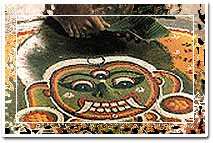 Kalampattu
(kalamezhuthu pattu) is a folk art form that belongs to the northern
regions of kerala. This art form, which is over 600 years old is performed
by a group of five to fifteen people in bhadrakali and ayyappa temples.
The ritual is performed around the kolam - an elaborate picture, usually
of bhadrakali, drawn on the floor, using five colours. The performance in
the light of temple torches lasts through the night. The singers are
neatly dressed with women wearing their hair on the side of the head. A
series of songs (kalampattu) are sung to the accompaniment of nanthuni and
elathalam.s
VELKALI
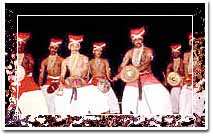 It
is one of the most elaborate and spectacular martial folk arts of kerala.
This ritual art form is usually presented within the temple premises and
is called thirumumbil vela when performed before the deity and
kulathilvela when performed near the temple pond. Fifty or more performers
in the traditional attire of soldiers, bearing colourful shields and
swords or long canes, dance with war like steps in perfect orchestration
with the resounding rhythm of the thakil, suddha maddalam, elathalam,
kuzhal and trumpets. A few fighting techniques of kalaripayattu are also
displayed in the course of the performance.
|


